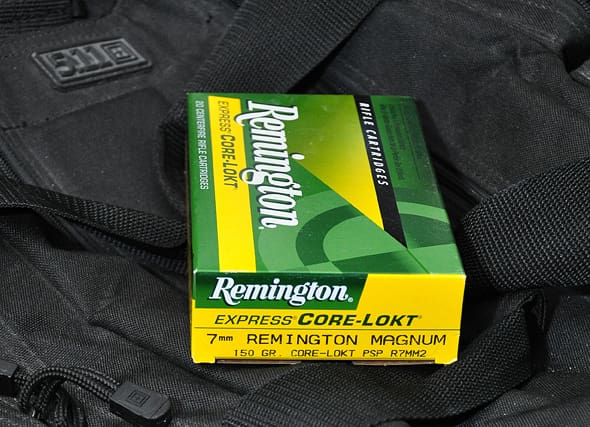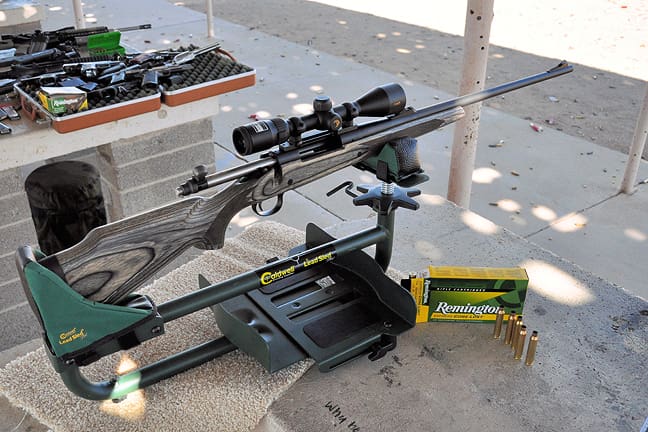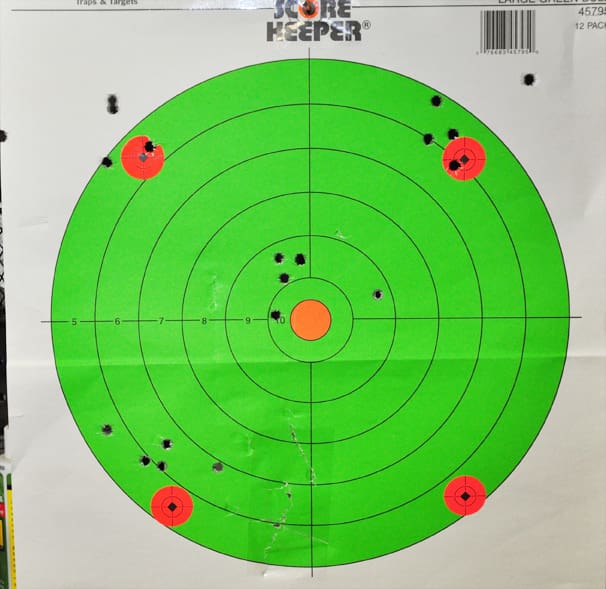So here I am (that’s not me above), with two stocks and a project at hand. What I’m not doing is looking to build a sniper rifle or to see how accurate I can make this gun. I decided to do this to see how beneficial pillar bedding and skimming a typical hunting rifle can be. It’s cheap to do, there’s tons of information online and I love tinkering in the garage. Now that that’s out of the way, here’s what I have planned and what I’ve done so far…
I bought 80 rounds (four boxes) of Remington Core-Lokt 150 grain ammo on the same day, from the same store, and – I assume – from the same lot. I took five rounds from each box, and randomly mixed the rounds together. The idea here is to ensure the rounds chosen are completely random and that the resulting variability is also as random as I can make it.
Since I already have this rifle sighted in at 100 yards with a 150 grain Federal round, I’m going to assume that POI won’t shift much. Just to make sure, though, I’m still going to shoot two rounds to verify POI and to “foul” the barrel. From here, I’ll let the barrel to fully cool down before beginning testing.
I’ll fire the gun a total of 20 times (after verifying POI) in 4 groups of 5. The barrel will be completely cool for Group #1 and Group #4. Flyers won’t be “called,” but I will only use the best 4 shots of each 5 shot group. I’ll calculate both vertical and horizontal stringing, as well as extreme measurements.
Then I’ll follow the instructions that came with the pillars and Acraglas and will do my best not to screw up the rifle. After waiting the appropriate amount of time, I’ll retest the rifle in the same manner as before hand and see how she does!
Before we start…
The OEM Remington LSS stock needed some TLC before I started testing. Recently, Remington has been of the mindset that a barrel pad is necessary and that a wee-bit of pressure on the barrel provides more accuracy. Translation: it’s cheaper to put a pad on each stock than to pay someone to check and make sure each finished rifle’s barrel is free-floated. Thanks for that, Freedom Group.
In any case, I sanded down the pad using some 120-grit sandpaper and a 7/16” socket. I verified that nothing was hitting or interfering with the stock and then buttoned everything back up. Using a torque-wrench, I tightened each trigger guard screw down to 35 in-lbs and was ready for testing. Good to go.
At the range…
I started testing by firing two “fouling” shots to remove any residual oil from the barrel and to verify POI. Everything checked out and I waited for the barrel to cool down. After fifteen minutes, the barrel was the same temperature as the ambient air and I set the rifle in my new Caldwell Lead Sled Plus (thanks for the early Christmas present, Santa!).
Here’s the testing order: five shots, five minute wait, five shots, five minute wait, five shots, about a twenty-five minute wait, and then five more shots. For the first and last set of five, the barrel was completely cooled. Each shot was loaded and shot individually, meaning I never had more than one cartridge in the gun at any one time.
[Note: For those who are interested, Group #1 is center, Group #2 is Upper Left, Group #3 is Upper Right, and Group #4 is Bottom Left]
Accuracy was about what I was expecting and more than sufficient for most hunting in North America. With Federal 150-grain Soft Point ammo and a cheapo SPS synthetic stock, my best groups were right around 2”.
The results for this day’s testing are tabulated below. As per my usual method of calculating groups, only the best 4 of each 5 shots were used for calculations. Taking the AOA, or “average of the averages” makes statistical sense in this case since all groups (i.e. number sets) are equally weighted. The AOA for all 20 shots came to 1.183”, just shy of 1-1/4”. The standard deviation of all 16 data points came to .327”, a bit over 5/16”. The standard deviation is high and would be even worse (way worse!) if we included all 5 shots per group in the calculations.
It’s these inconsistencies that I’m looking to fix.
|
7mm Rem Mag Remington Core-Lokt 150-gr PSP R7MM2 |
Group 1* |
Group 2 |
Group 3 |
Group 4* |
Avg (rows) |
Std Dev (rows) |
|
Vertical Spread (in) |
1.279 |
1.341 |
1.466 |
0.841 |
1.232 |
0.272 |
|
Horizontal Spread (in) |
0.466 |
0.997 |
0.529 |
1.404 |
0.849 |
0.439 |
|
Extreme Spread (in) |
1.504 |
1.404 |
1.497 |
1.466 |
1.468 |
0.046 |
|
Avg Spread (in) |
1.083 |
1.247 |
1.164 |
1.237 |
1.183 |
NA |
|
Accuracy Testing – Best 4 of 5 rounds, 100 yards, 70F, pre-bedding, (*) denotes a cold barrel |
||||||
Hopefully we can fix that. Next up: bedding and skimming. Stay tuned for a complete write-up and how-to along with parts II and III.







Remmy has been using cheap pressure-pad stocks on their ADL line for decades. I never thought they’d cheapen their flagship BDL line with them too.
When I purchased the stock, I was surprised to see it as well. The stock is from a VSS model, not a “cheap” variant by any means…
I appreciate that you are taking the time to methodically test these variables and share them with us.
I look forward to your follow-ups.
Thanks also. Wondering if the effort would be worth it on an older Win 70-270 with a wooden stock.
Get a group similar but a bit more spread out as your #1 with the 130g Core Lokts, whilst propped on top of the cheap sand bags at Walmart.
Those “Winchester” branded bags? I use those quite a bit, actually I really only use the rear one most of the time. The front is on a smaller Caldwell stand or a bipod. However, I have used both bags with good results, but the Lead Sled Plus ensures that one of the variables (me) is out of the equation (for the most part).
Yup- the same. I prop the front one on something like gun bag or boxes of bullets, so its not so wiggly. PS: now that I think back, my groups were at 75 yds, not 100 so I REALLY could use some help!
You should have shot groups before sanding the pad so you could compare free float to single point pressure. What I’ve read and been told is that thinner, sporter barrels do better with a little pressure to dampen the whip.
It would be interesting to see groups before and after changes you made to your Remington 700.
Comments are closed.